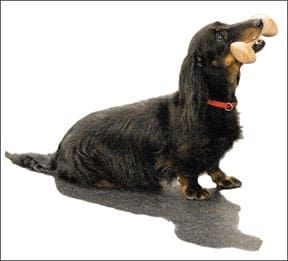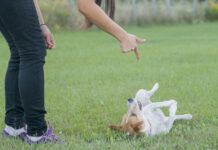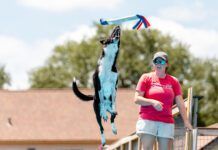[Updated March 23, 2018]
CANINE COMPETITIVE OBEDIENCE OVERVIEW
What is this sport? The handler directs the dog through a series of highly stylized behaviors that demonstrate control, accuracy, and precision from both handler and dog.
Prior training required? Minimal.
Physical demands? On the dog: Low to moderate. On the handler: Low.
Best-suited body structure? With some exceptions, this is a low-impact sport that does not favor a particular body structure.
Best-suited temperament? Dogs who do best like to train and can tolerate a lot of repetition.
Cost? Moderate to high.
Training complexity? Moderate.
Mental stimulation? High.
Physical stimulation? Moderate.
Recreational opportunities? Low.
Competition opportunities and venues? Moderate.
You could hear a pin drop. The bleachers and chairs are jammed with an audience holding its collective breath as the handler-dog team on the floor completes their final exercise in the American Kennel Club’s (AKC) National Obedience Invitational, an annual event that tests the best in the sport. The team that wins this final round has competed for several days in multiple classes, demonstrating the mental and physical stamina, as well as the training “chops,” that gave them a shot at this premier event. Precision heeling, directed retrieving, scent discrimination, directed jumping, and hand signals from a distance are the hallmarks of this level of competition. Points are taken off for the slightest of mistakes.
The crowd erupts – whistling, clapping, and shouting its approval of this team’s performance: Petra Ford and Tyler, her black Labrador, have just delivered a performance that takes first place for the second year in a row and leaves members of the audience shaking their heads in disbelief. That was not only good, it was awesome. The crowd, most of them obedience competitors themselves, knows what that kind of performance takes in terms of dedication to this sport.
History of Competitive Obedience
The first obedience test was created by Helen Whitehouse Walker in Mt. Kisco, New York, in 1933. By 1936, the AKC had adopted standards and 18 trials were held across the United States. Additional organizations have been established since then to award titles to teams that compete in the sport.
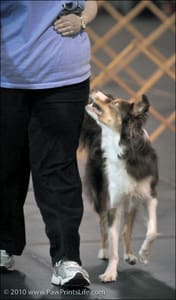
The AKC’s original philosophy was to create a series of exercises that would “demonstrate the usefulness of a dog as a companion to humankind.” The Australian Shepherd Club of America states it this way: “The purpose of Obedience Trials is to demonstrate the usefulness of the dog as a companion of man, not merely the dog’s ability to follow specified routines in the obedience ring. The basic objective of Obedience Trials is to produce dogs that have been trained and conditioned always to behave in the home, in public places, and in the presence of other dogs.”
Competition obedience was for many years the only “dog sport” available. As a result, it developed a strong following, providing an outlet for dog people to go on to advanced training and competition outside the conformation ring.
But as other dog sports were created, the face of competition obedience has changed. Many of its competitors have been enticed by other sports – particularly those that are easier to learn and those that dogs enjoy more. Agility, in particular, has drawn such huge numbers of obedience competitors that the AKC is concerned about diminishing entries in its shows.
On its website, the AKC states, “Obedience entries have continued a steady decline over the past 10 years.” However, it’s not simply the advent of additional sports that appears to have affected the popularity of competition obedience. As we will explore in this article, the rising popularity of positive reinforcement training methods, especially clicker training, has deterred some handlers from participating in a sport that has a history of compulsion-based training.
Competition Categories
The AKC’s five levels of competition are generally accepted as the standard for the sport. Each handler/dog team starts with a perfect score of 200, and points are deducted for errors. A score of 170 or higher is required to qualify, and you need three qualifying “legs” under three different judges to earn titles.
• Novice: The Companion Dog (CD) title is the AKC’s novice title. Exercises are performed both on- and off-leash and include the following exercises: heeling on-leash in a figure 8 pattern; heeling off-leash in a pattern directed by the judge; come when called; stand for exam with the handler a short distance away; a one-minute sit-stay with the handler across the ring; and a three-minute down-stay with the handler across the ring. Both the “long sit” and the “long down” are performed in a group of other dogs.
• Open: The Companion Dog Excellent (CDX) is the AKC’s open title. All the exercises are performed off-leash and entail heeling, retrieving, and jumping. In addition to the long sit and the long down, exercises include heeling in a pattern directed by the judge and a figure 8; the “drop on recall,” in which a dog is called to the handler from a sit-stay across the ring, and then, upon direction from the judge, is cued to lie down; the “retrieve on the flat,” in which the dog is sent to a dumbbell, picks it up, and returns to and sits in front of the handler, and holds onto the dumbbell until commanded to drop it into the handler’s hands; a “retrieve over a high jump”; and performing the broad jump.
• Utility: The Utility Dog (UD) is the AKC’s utility title. All exercises are performed off-leash and focus on advanced retrieving and exercises at a distance from the handler. One of these exercises entails scent discrimination, in which the dog must identify and pick up the dumbbell with the handler’s scent from a pile of other dumbbells (which are called “articles”).
Another exercise is the “directed retrieve,” in which the dog is directed to retrieve one of three gloves. In “directed jumping,” the dog must jump over a specific obstacle. In the “signal exercise,” the dogs is cued (with hand signals only) to stand-stay in heel position when the handler stops, walks away, and turns to face the dog. Then she signals the dog to down, then sit, come, and return (“finish”) to heel position. In the “moving stand and examination,” while heeling, the dog is cued to stop, stand, and stay while the handler moves away and the judge performs a brief physical examination, after which the dog is cued to return to heel position.
• Utility Excellent: The Utility Dog Excellent (UDX) title requires a combination of qualifying legs in both Open B and Utility B on the same day. (A dog is considered to be in “B” after completing the UD title.) Ten such double qualifying scores are required to earn the UDX.
• Obedience Trial Championship: The coveted OTCH is the pinnacle of AKC competition obedience. It requires the team to earn 100 points by placing first through fourth places. Point values are based on a formula of placements and the number of dogs competing that day in Open B and Utility B classes. Teams can accumulate OTCH points while simultaneously working toward their UDX title.
The top OTCH dogs vie for an invitation to the AKC’s National Obedience Invitational, which invites the teams with the most OTCH points within a particular breed. The winner in each breed earns the National Obedience Champion (NOC) designation.The AKC has recently added other titling events to the sport, effective in April 2010. See the websites listed to the right.
Training
There are at least two subcultures within this sport. One is comprised of people who train hard and title with qualifying scores between 170 and the low 190s. Another is made up of a smaller group of people whose lives revolve around training and competing for scores in the rarified air of the upper 190s. Remember, a perfect score is 200. Slightly out of position on the heel? That’s 2 points off. A crooked “front”? That’s another 2 points deducted. One more of those and you’re no longer in the running for the coveted score of 195 or above. Going for an OTCH, the creme de la creme of AKC obedience? Esther Zimmerman of Hopkinton, Massachusetts, has been competing since 1976 and has earned CH/UDs on two Schipperkes and a CH/UDX and OTCH points on another one.
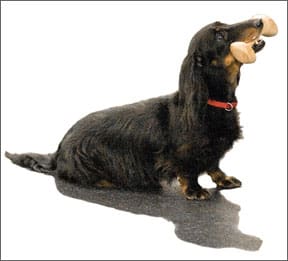
COPYRIGHT © 2010
“When the AKC conceived the OTCH, its intention was for there to be approximately 100 new OTCHs earned each year. And that has been the case, with the fewest being 79, and the most being about 115 since the mid 1970s.
“That’s a tiny percentage of all the people who compete in the sport. Those people have to be excellent trainers, regardless of the techniques they use. They have to have dogs that are healthy enough to train and compete for years, which is luck of the draw to some degree. They have to have time to train many hours every week. They have to have a lot of money to spend on training, entries, hotel expenses, gasoline, etc. They have to defeat other dogs to get placements and earn points. It is an amazing achievement to earn an OTCH.”
So why do people keep coming back for more if it’s so difficult and the opportunity cost is so high? Deborah Jones, PhD, co-author of In Focus and owner/moderator of the ClickCompObed Yahoo discussion list, which promotes the use of clicker training in the sport, tries to explain the allure of a sport that requires such precision.
“I remember the first time I saw competition obedience in about 1992. I immediately thought ‘I can do that!’ I had no idea how complex and precise the exercises actually were. I’ve been training toward that elusive perfect performance ever since. Sometimes some of the exercises are nearly perfect and every once in a while, one or two are totally perfect. But to get it all to come together at the right moment is like chasing a moving target. Each exercise and each dog offer totally unexpected and unique challenges.”
For those like Jones, competition obedience presents challenges that no other sport does. In addition to the difficulty of teaching a dog to heel in an exact location, without lagging or forging, which can takes months, you must train your dog to do many exercises that require you to be as precise as you expect your dog to be. Footwork is a notorious challenge for many novice handlers. A foot out of place can send your dog wide around your body in an “about-turn,” costing you precious points off your score. Many people find obedience training as a result of a search for basic training for their out-of-control or rambunctious adolescent dogs.
Jones, a psychology professor at Kent State University, rescued Katie, an 18-month-old black Labrador in 1992. Katie had been in three different homes and had been living in the woods for six months before Jones adopted her. Katie was a handful. Jones was in graduate school at the time and was told by several people that she didn’t have time to devote to a dog.
“It turned out to be the best decision I ever made. I took Katie to a training class and was introduced to the world of dog performance events. At that time obedience was the ‘only game in town’ if you wanted to train and compete so I became involved with a local AKC club. I was drawn to obedience because I enjoy training challenges and wanted to see if I could achieve the same results that others did. At that time I didn’t realize how forceful and coercive some of the training methods were. Once I did, I wanted to find a better way to train for competition.”
That is the challenge of this sport. Although many trainers start puppy training with mostly positives, many later resort to severe collar corrections, ear pinches (to cause sufficient pain for the dog to open its mouth into which a dumbbell is forced), hitting and slapping (e.g., under the chin to correct the dog for mouthing or dropping the dumbbell and on the head or nose for breaking a stay).
Much of this is done in the belief that there is no other way; after all, dogs are getting titles with trainers using these techniques. This is compounded by the fact that, unless you are an astute observer of canine body language, you might miss the stress signs that dogs in the ring are showing (yawning, lip licking, averting eyes from handlers, increased respiration, avoidance of handlers and their hands, flinching, and either slowing down or frenetic speeding up).
Additionally, old-time trainers who have been in the sport for many, many years point to the lack of advanced obedience titles in the ranks of positive reinforcement trainers as justification for their training methods.
Zimmerman, with Siesta Schipperkes, sees a progressive shift in the sport. “There have not been enough people doing clicker training for competition obedience long enough for the question to be fairly asked [about whether there are clicker-trained OTCHs]. Given enough time, there will be more! I have been competing since 1976 and have had the great good fortune to have two Schipperkes earn their UDs, and one who earned his UDX and 12 OTCH points. They were entirely trained with positive methods – not exclusively clicker training, but as positive as we could make it.”
If you have been tempted to try competition obedience, but have been turned off by some of the training methods you see being used, don’t give up. Better yet, jump in with both feet. It may take a bit of research to find other positive reinforcement obedience handlers and instructors, but it can be worth the effort. More and more top teams are using positives and seeing the difference in attitude with their dogs.
Jones, who has been clicker training for 18 years, teaches competition classes and workshops and is now competing with Zen, her two-year-old, red-and-white Border Collie, preparing him to go on from earning his CD and CDX to Utility. It was Copper, her Papillon, however, who reaffirmed her commitment to using positives in training for the sport.
She says, “Earning Copper’s agility MACH (AKC’s Master Agility Championship) and two weeks later earning his UD were two of my proudest achievements as Copper is a very soft and sensitive dog. He was trained for both agility and obedience without a single correction or aversive.
“People keep saying you can’t get precision and accuracy with a dog unless you use ‘corrections.’ I strongly disagree. It doesn’t make any sense from a learning theory perspective. Behaviors taught using punishment aren’t any stronger than those taught using reinforcement; just the opposite. Punishment-based training is riddled with pitfalls, even if you do it ‘right.’ The worst thing that can happen with errors in reinforcement-based training is that your dog gets a few extra cookies.
“The newest buzzword is ‘balanced’ training, in which trainers use both reinforcement and punishment in their methods. Be very, very careful about accepting this as a reasonable compromise. A few cookies do not cancel out the use of force.”
Now that you know it can be done positively, what are your biggest training challenges? According to Jones, heeling is most people’s nemesis. It requires the handler to train themselves to walk a very straight line (not as easy as it sounds), and to be able to break heeling down into very tiny components for the dog to be successful. Another difficult exercise is the “go-out” in Utility. Jones notes, “Getting a dog to run straight to nowhere can be quite challenging. Asking him to do it over and over again in the ring seems to be problematic. That exercise requires lots of upkeep. In Open, the out-of-sight stays seem to cause the most problems for people and their dogs. Everyone is anxious about them!”
Jones recommends starting with basic manners and tricks before starting serious obedience training. Tricks, especially, help you hone your observation and timing skills, both of which will be invaluable when you start training obedience exercises. Many clicker trainers will also tell you that working together to solve a training game builds strong teamwork between the two species. A relationship built on mutual fun and “playing” together will benefit you when you begin teaching more complex obedience behaviors.
Competitive Obedience Team Attributes
People who are attracted to this sport must enjoy training because it takes a lot of it to be successful. Even with the most talented and workaholic dogs, it still takes a lot of work to train to advanced levels and to keep it fun for dog and handler. Jones is typical of many people who keep returning to the sport.
“I love the challenge of making obedience fun and exciting for my dogs,” she says. “I want them to think of it as one big game. I see many, many unhappy dogs in obedience competition. With every dog I own I get a little better as a trainer and we get a little closer to perfection. I love the challenge of taking exercises that people insist must be taught with aversives and force, and finding a positive way to get results. I also like the opportunity to test my training on a fairly objective scale [by competing].”
Jones notes other human attributes: “Some people in this sport are extremely controlling and a bit on the Type A side – intense and competitive. Others enjoy just having fun with their dogs and spending social time at trials with friends.”
Equipment and Expenses
Expenses fall into three categories:
• Training equipment: Costs will vary widely, but plan on buying things such as scent discrimination articles (a set of metal ones and a set of leather ones), retrieving dumbbells, ring gating, jumps, and a variety of training props (many made from simple PVC pipes).
• Classes and workshops: The cost of weekly classes runs $75 to $150 for a 6- to 8-week course. Private lessons range from $40 to $125 an hour, while a one-day workshop costs between $75 and $225. Practice matches cost $5 per “run through” when you can find them.
• Trial and travel expenses: Travel will be dictated by how far you must travel to find a trial, which varies widely across the country. Competition entry fees cost about $25 to $30 per class. In novice and open, you will typically have only one class in a day. After you have earned your UD, you will need to budget for both the Open B and Utility B classes.
Get Started
If you have not explored clicker training, it would be well worth your time to try it. Knowing that you don’t need to be an adversary in your training can make this sport very appealing. Jones, who says it can be lonely being the only positive trainer at an event, says how you train says a lot about who you are:
“Clicker training is part of who I am as a trainer. It goes so far beyond using a clicker . . . it goes against my nature to use force or aversive in training my dog. I feel very strongly that we should both enjoy this process or we shouldn’t be doing it!” So grab that clicker, start training, and be part of the next generation of positive competition obedience trainers.
Terry Long, CPDT, is a writer, agility instructor, and behavior counselor in Long Beach, CA. She lives with four dogs and a cat and is addicted to agility and animal behavior. See page 24 for contact info.


